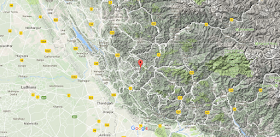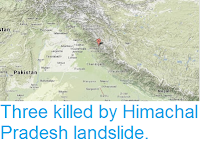Fifteen families have been evacuated from their homes after a landslide close to the town of Bhattakufer in Shimla District, Himachal Pradesh on Saturday 2 September 2017. The incident happened at about 1.40 pm local time, when a section of cliff-face collapsed onto the Chandigarh-Shimla National Highway close to the Dhalli Tunnel, crushing between six and eight cars and damaging several houses and a temple. Nobody was hurt in the incident, but the area is still thought to be unsafe and people have been evacuated as a precaution.
The scene of the 2 September 2017 Bhattakufer landslide. Press Trust of India.
The incident happened after about three days of continuous rain, associated with the Indian Summer Monsoon. Mountainous areas of Himachal Pradesh (which is
most of the state) are notoriously prone to landslides, particularly
during the monsoon season, which lasts from July to September, when very
high rainfall levels can trigger many such events. Landslides are a common problem after severe weather, as excess
pore water pressure can overcome cohesion in soil and sediments,
allowing them to flow like liquids. Approximately 90% of all landslides
are caused by heavy rainfall.
The approximate location of the 2 September 2017 Bhattakufer landslide. Google Maps.
Monsoons
are tropical sea breezes triggered by heating of the land during the
warmer part of the year (summer). Both the land and sea are warmed by
the Sun, but the land has a lower ability to absorb heat, radiating it
back so that the air above landmasses becomes significantly warmer than
that over the sea, causing the air above the land to rise and drawing in
water from over the sea; since this has also been warmed it carries a
high evaporated water content, and brings with it heavy rainfall. In the
tropical dry season the situation is reversed, as the air over the land
cools more rapidly with the seasons, leading to warmer air over the
sea, and thus breezes moving from the shore to the sea (where air is
rising more rapidly) and a drying of the climate. This situation is
particularly intense in South Asia, due to the presence of the
Himalayas. High mountain ranges tend to force winds hitting them
upwards, which amplifies the South Asian Summer Monsoon, with higher
winds leading to more upward air movement, thus drawing in further air
from the sea.
Diagrammatic representation of wind and rainfall patterns in a tropical monsoon climate. Geosciences/University of Arizona.
See also...
Follow Sciency Thoughts on Facebook.









